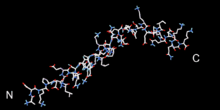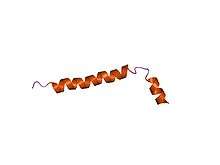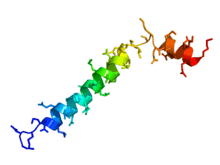Beta thymosins

Beta thymosins are a family of proteins which have in common a sequence of about 40 amino acids similar to the small protein thymosin β4. They are found almost exclusively in multicellular animals. Thymosin β4 was originally obtained from the thymus in company with several other small proteins which although named collectively "thymosins" are now known to be structurally and genetically unrelated and present in many different animal tissues.
See also
Single domain β-thymosins
Distribution
| Thymosin beta-4 family | |||||||||
|---|---|---|---|---|---|---|---|---|---|
 Structure of thymosin beta 9.[3] | |||||||||
| Identifiers | |||||||||
| Symbol | Thymosin | ||||||||
| Pfam | PF01290 | ||||||||
| InterPro | IPR001152 | ||||||||
| SMART | SM00152 | ||||||||
| PROSITE | PDOC00433 | ||||||||
| SCOP | 1hj0 | ||||||||
| SUPERFAMILY | 1hj0 | ||||||||
| |||||||||
Monomeric β-thymosins, i.e. those of molecular weight similar to the peptides originally isolated from thymus by Goldstein, are found almost exclusively in cells of multicellular animals.[4] Known exceptions are monomeric thymosins found in a few single-celled organisms, significantly those currently regarded as the closest relatives of multicellular animals:[5] choanoflagellates [6] and filastereans.[7] Although found in very early-diverged animals such as sponges, monomeric thymosins are absent from arthropods and nematodes, which do nevertheless possess "β-thymosin repeat proteins" which are constructed from several end-to-end repeats of β-thymosin sequences.[8] Genomics has shown that tetrapods (land vertebrates) each express three monomeric β-thymosins, which are the animal species' equivalents (orthologues) of human β4, β10 and β15 thymosins, respectively. The human thymosins are encoded by the genes TMSB4X, TMSB10 and TMSB15A and TMSB15B. (In humans, the proteins encoded by the two TMSB15 genes are identical.) Bony fish in general express orthologues of these same three, plus an additional copy of the β4 orthologue.[9]
| family | gene | locus | protein |
|---|---|---|---|
| β4 | TMSB4X | Chr. X q21.3-q22 | Thymosin β4 |
| TMSB4Y | Chr. Y | Thymosin β4, Y-chromosomal | |
| β10 | TMSB10 | Chr. 2 p11.2 | Thymosin β10 |
| β15 | TMSB15A | Chr. X q21.33-q22.3 | Thymosin β15 |
| TMSB15B | Chr. X q22.2 | Thymosin β15 |
Relation to the WH2 sequence module
The N-terminal half of β-thymosins bears a strong similarity in amino acid sequence to a very widely distributed sequence module, the WH2 module. (Wasp Homology Domain 2 - the name is derived from Wiskott-Aldrich syndrome protein).[10][11] Evidence from X-ray crystallography shows that this part of β-thymosins binds to actin in a near-identical manner to that of WH2 modules, both adopting as they bind, a conformation which has been referred to as the β-thymosin/WH2 fold. β-thymosins may therefore have evolved by addition of novel C-terminal sequence to an ancestral WH2 module.[12] However, sequence similarity searches designed to identify present-day WH2 domains[13] fail to recognise β-thymosins, (and vice versa) and the sequence and functional similarities may result from convergent evolution.[14]
Biological activities of thymosin β4
The archetypical β-thymosin is β4 (product in humans of the TMSB4X gene), which is a major cellular constituent in many tissues. Its intracellular concentration may reach as high as 0.5 mM.[15] Following Thymosin α1, β4 was the second of the biologically active peptides from Thymosin Fraction 5 to be completely sequenced and synthesized.[16]
Any concepts of the biological role of thymosin β4 must inevitably be coloured by the demonstration that total ablation of the thymosin β4 gene in the mouse allows apparently normal embryonic development of mice which are fertile as adults.[17]
Actin binding
Thymosin β4 was initially perceived as a thymic hormone. However this changed when it was discovered that it forms a 1:1 complex with G (globular) actin, and is present at high concentration in a wide range of mammalian cell types.[18] When appropriate, G-actin monomers polymerize to form F (filamentous) actin, which, together with other proteins that bind to actin, comprise cellular microfilaments. Formation by G-actin of the complex with β-thymosin (= "sequestration") opposes this.
Due to its profusion in the cytosol and its ability to bind G-actin but not F-actin, thymosin β4 is regarded as the principal actin-sequestering protein in many cell types. Thymosin β4 functions like a buffer for monomeric actin as represented in the following reaction:[19]
F-actin ↔ G-actin + Thymosin β4 ↔ G-actin/Thymosin β4
Release of G-actin monomers from thymosin β4 occurs as part of the mechanism that drives actin polymerization in the normal function of the cytoskeleton in cell morphology and cell motility.
The sequence lkktet, which starts at residue 17 of the 43-aminoacid sequence of thymosin beta-4, and is strongly conserved between all β-thymosins, together with a similar sequence in WH2 domains, is frequently referred to as "the actin-binding motif" of these proteins, although modelling based on X-ray crystallography has shown that essentially the entire length of the β-thymosin sequence interacts with actin in the actin-thymosin complex.[20]
"Moonlighting"
In addition to its intracellular role as the major actin-sequestering molecule in cells of many multicellular animals, thymosin β4 shows a remarkably diverse range of effects when present in the fluid surrounding animal tissue cells. Taken together, these effects suggest that thymosin has a general role in tissue regeneration. This has suggested a variety of possible therapeutic applications, and several have now been extended to animal models and human clinical trials.
It is considered unlikely that thymosin β4 exerts all these effects via intracellular sequestration of G-actin. This would require its uptake by cells, and moreover, in most cases the cells affected already have substantial intracellular concentrations.
The diverse activities related to tissue repair may depend on interactions with receptors quite distinct from actin and possessing extracellular ligand-binding domains. Such multi-tasking by, or "partner promiscuity" of, proteins has been referred to as protein moonlighting.[21] Proteins such as thymosins which lack stable folded structure in aqueous solution, are known as intrinsically unstructured proteins (IUPs). Because IUPs acquire specific folded structures only on binding to their partner proteins, they offer special possibilities for interaction with multiple partners.[22] A candidate extracellular receptor of high affinity for thymosin β4 is the β subunit of cell surface-located ATP synthase, which would allow extracellular thymosin to signal via a purinergic receptor.[23]
Some of the multiple activities of thymosin β4 unrelated to actin may be mediated by a tetrapeptide enzymically-cleaved from its N-terminus, N-acetyl-ser-asp-lys-pro, brand names Seraspenide or Goralatide, best known as an inhibitor of the proliferation of haematopoietic (blood-cell precursor) stem cells of bone marrow.
Tissue regeneration
Work with cell cultures and experiments with animals have shown that administration of thymosin β4 can promote migration of cells, formation of blood vessels, maturation of stem cells, survival of various cell types and lowering of the production of pro-inflammatory cytokines. These multiple properties have provided the impetus for a worldwide series of on-going clinical trials of potential effectiveness of thymosin β4 in promoting repair of wounds in skin, cornea and heart.[24]
Such tissue-regenerating properties of thymosin β4 may ultimately contribute to repair of human heart muscle damaged by heart disease and heart attack. In mice, administration of thymosin β4 has been shown to stimulate formation of new heart muscle cells from otherwise inactive precursor cells present in the outer lining of adult hearts,[25] to induce migration of these cells into heart muscle[26] and recruit new blood vessels within the muscle.[27]
Anti-inflammatory role for sulfoxide
In 1999 researchers in Glasgow University found that an oxidised derivative of thymosin β4 (the sulfoxide, in which an oxygen atom is added to the methionine near the N-terminus) exerted several potentially anti-inflammatory effects on neutrophil leucocytes. It promoted their dispersion from a focus, inhibited their response to a small peptide (F-Met-Leu-Phe) which attracts them to sites of bacterial infection and lowered their adhesion to endothelial cells. (Adhesion to endothelial cells of blood vessel walls is pre-requisite for these cells to leave the bloodstream and invade infected tissue). A possible anti-inflammatory role for the β4 sulfoxide was supported by the group's finding that it counteracted artificially-induced inflammation in mice.
The group had first identified the thymosin sulfoxide as an active factor in culture fluid of cells responding to treatment with a steroid hormone, suggesting that its formation might form part of the mechanism by which steroids exert anti-inflammatory effects. Extracellular thymosin β4 would be readily oxidised to the sulfoxide in vivo at sites of inflammation, by the respiratory burst.[28]
Terminal deoxynucleotidyl transferase
Thymosin β4 induces the activity of the enzyme terminal deoxynucleotidyl transferase in populations of thymocytes (thymus-derived lymphocytes). This suggests that the peptide may contribute to the maturation of these cells.[16]
Clinical applications
Thymosin β4 has been tested in multicenter trials sponsored jointly by RegeneRx Biopharmaceuticals Inc (Rockville, MD, USA) and Sigma Tau (Pomezia, Italy) in the United States and Europe in patients with bed sores, ulcers caused by venostasis, and Epidermolysis bullosa simplex and was found to accelerate bed sore and stasis ulcer repair by one month. The epidermolysis bullosa trial is still enrolling. It has also been tested in patients with chronic neurotrophic corneal epithelial defects and found to promote repair.
Levels of human thymosin β15 in urine have shown promise as a diagnostic marker for prostate cancer which is sensitive to potential aggressiveness of the tumour [29]
Doping in sports
Thymosin beta-4 was allegedly used by some players in various Australian football codes and is under investigation by the Australian Sports Anti-Doping Authority for anti-doping violations [30]
β-thymosin repeat proteins
Distribution
These proteins, which typically contain 2-4 repeats of the β-thymosin sequence, are found in all phyla of the animal kingdom, with the probable exception of sponges[31] The sole mammalian example, a dimer in mice, is synthesised by transcriptional read-through between two copies of the mouse β15 gene, each of which is also transcribed separately.[32] A uniquely multiple example is the protein thypedin of Hydra which has 27 repeats of a β-thymosin sequence.[33]
Biological activities
β-thymosin repeat proteins resemble the monomeric forms in being able to bind to actin, but sequence differences in one example studied, a three-repeat protein Ciboulot of the fruit fly Drosophila, allow binding to ends of actin filaments, an activity which differs from monomer sequestration.[34]
These proteins became of interest in neurobiology with the finding that in the nudibranch (sea slug) Hermissenda crassicornis, the protein Csp24 (conditioned stimulus pathway phosphoprotein-24), with 4 repeats, is involved in simple forms of learning: both one-trial enhancement of the excitability of sensory neurons in the conditioned stimulus pathway,[35] and in multi-trial Pavlovian conditioning.[36] The phosphorylation of Csp24, in common with post-translational modifications of a number of cytoskeleton-related proteins may contribute to actin-filament dynamics underlying structural remodeling of responsive cells.[36]
Picture gallery
-

NMR structure of bovine β9-thymosin, the orthologue of human β10.[1] Rainbow coloured where the N-terminus = blue and the C-terminus = red.
- ^ PDB: 1HJ0; Stoll R, Voelter W, Holak TA (May 1997). "Conformation of thymosin beta 9 in water/fluoroalcohol solution determined by NMR spectroscopy". Biopolymers. 41 (6): 623–34. doi:10.1002/(SICI)1097-0282(199705)41:6<623::AID-BIP3>3.0.CO;2-S. PMID 9108730.
The thymosin is β9, bovine orthologue of human β10. Stabilised by organic solvent, the structure was determined by NMR. (Free β-thymosins lack a stable fold in solution)
References
- ↑ Grottesi A, Sette M, Palamara T, Rotilio G, Garaci E, Paci M (1998). "The conformation of peptide thymosin alpha 1 in solution and in a membrane-like environment by circular dichroism and NMR spectroscopy. A possible model for its interaction with the lymphocyte membrane". Peptides. 19 (10): 1731–8. doi:10.1016/S0196-9781(98)00132-6. PMID 9880079.
- ↑
- ↑ Stoll R, Voelter W, Holak TA (May 1997). "Conformation of thymosin beta 9 in water/fluoroalcohol solution determined by NMR spectroscopy". Biopolymers. 41 (6): 623–34. doi:10.1002/(SICI)1097-0282(199705)41:6<623::AID-BIP3>3.0.CO;2-S. PMID 9108730.
- ↑ "Family: Thymosin (PF01290)". Pfam. Wellcome Trust Sanger Institute.
- ↑ Shalchian-Tabrizi K, Minge MA, Espelund M, Orr R, Ruden T, Jakobsen KS, Cavalier-Smith T (2008). "Multigene phylogeny of choanozoa and the origin of animals". PLoS ONE. 3 (5): e2098. Bibcode:2008PLoSO...3.2098S. doi:10.1371/journal.pone.0002098. PMC 2346548
 . PMID 18461162.
. PMID 18461162. - ↑ "XYM2758.rev XYM Monosiga brevicollis rapidly growi... - EST result".
- ↑ "NUE00005552 Capsaspora owczarzaki Amplicon express Capsaspora owczarza - EST - NCBI"..
- ↑ Manuel M, Kruse M, Müller WE, Le Parco Y (October 2000). "The comparison of beta-thymosin homologues among metazoa supports an arthropod-nematode clade". J. Mol. Evol. 51 (4): 378–81. doi:10.1007/s002390010100 (inactive 2015-01-10). PMID 11040289.
- ↑ Edwards J (March 2010). "Vertebrate beta-thymosins: conserved synteny reveals the relationship between those of bony fish and of land vertebrates". FEBS Lett. 584 (5): 1047–53. doi:10.1016/j.febslet.2010.02.004. PMID 20138884.
- ↑ Paunola E, Mattila PK, Lappalainen P (February 2002). "WH2 domain: a small, versatile adapter for actin monomers". FEBS Lett. 513 (1): 92–7. doi:10.1016/S0014-5793(01)03242-2. PMID 11911886.
- ↑ "Family: WH2 (PF02205)". Pfam. Wellcome Trust Sanger Institute.
- ↑ Dominguez R (September 2007). "The beta-thymosin/WH2 fold: multifunctionality and structure". Annals of the New York Academy of Sciences. 1112: 86–94. Bibcode:2007NYASA1112...86D. doi:10.1196/annals.1415.011. PMID 17468236.
- ↑ "Family: WH2 (PF02205)". Pfam. Wellcome Trust Sanger Institute.
- ↑ Edwards J (August 2004). "Are beta-thymosins WH2 domains?". FEBS Lett. 573 (1–3): 231–2; author reply 233. doi:10.1016/j.febslet.2004.07.038. PMID 15328003.
- ↑ Hannappel E (September 2007). "beta-Thymosins". Annals of the New York Academy of Sciences. 1112: 21–37. Bibcode:2007NYASA1112...21H. doi:10.1196/annals.1415.018. PMID 17468232.
- 1 2 Low TL, Hu SK, Goldstein AL (February 1981). "Complete amino acid sequence of bovine thymosin beta 4: a thymic hormone that induces terminal deoxynucleotidyl transferase activity in thymocyte populations". Proceedings of the National Academy of Sciences of the United States of America. 78 (2): 1162–6. Bibcode:1981PNAS...78.1162L. doi:10.1073/pnas.78.2.1162. PMC 319967
 . PMID 6940133.
. PMID 6940133. - ↑ Banerjee I, Zhang J, Moore-Morris T, Lange S, Shen T, Dalton ND, Gu Y, Peterson KL, Evans SM, Chen J (Feb 2012). "Thymosin beta 4 is dispensable for murine cardiac development and function". Circ Res. 110 (3): 456–64. doi:10.1161/CIRCRESAHA.111.258616. PMC 3739283
 . PMID 22158707.
. PMID 22158707. - ↑ Safer D, Elzinga M, Nachmias VT (March 1991). "Thymosin beta 4 and Fx, an actin-sequestering peptide, are indistinguishable". J. Biol. Chem. 266 (7): 4029–32. PMID 1999398.
- ↑ Lodish, Harvey F. (2000). "Chapter 18. Cell Motility and Shape I: Microfilaments. 18.2. The Dynamics of Actin Assembly". Molecular cell biology. San Francisco: W.H. Freeman. ISBN 0-7167-3706-X.
- ↑ Xue B, Aguda AH, Robinson RC (September 2007). "Models of the actin-bound forms of the beta-thymosins". Annals of the New York Academy of Sciences. 1112: 56–66. Bibcode:2007NYASA1112...56X. doi:10.1196/annals.1415.010. PMID 17468228.
- ↑ Jeffery CJ (January 1999). "Moonlighting proteins". Trends Biochem. Sci. 24 (1): 8–11. doi:10.1016/S0968-0004(98)01335-8. PMID 10087914.
- ↑ Tompa P, Szász C, Buday L (September 2005). "Structural disorder throws new light on moonlighting". Trends Biochem. Sci. 30 (9): 484–9. doi:10.1016/j.tibs.2005.07.008. PMID 16054818.
- ↑ Freeman KW, Bowman BR, Zetter BR (November 2010). "Regenerative protein thymosin {beta}-4 is a novel regulator of purinergic signaling". FASEB J. 25 (3): 907–15. doi:10.1096/fj.10-169417. PMID 21106936.
- ↑ Philp D, Kleinman HK (April 2010). "Animal studies with thymosin beta, a multifunctional tissue repair and regeneration peptide". Annals of the New York Academy of Sciences. 1194: 81–6. Bibcode:2010NYASA1194...81P. doi:10.1111/j.1749-6632.2010.05479.x. PMID 20536453.
- ↑ Smart N, Bollini S, Dubé KN, Vieira JM, Zhou B, Davidson S, Yellon D, Riegler J, Price AN, Lythgoe MF, Pu WT, Riley PR (June 2011). "De novo cardiomyocytes from within the activated adult heart after injury". Nature. 474 (7353): 640–4. doi:10.1038/nature10188. PMC 3696525
 . PMID 21654746. Lay summary – BBC News.
. PMID 21654746. Lay summary – BBC News. - ↑ Smart N, Riley PR (February 2009). "Derivation of epicardium-derived progenitor cells (EPDCs) from adult epicardium". Curr Protoc Stem Cell Biol. Chapter 2: Unit2C.2. doi:10.1002/9780470151808.sc02c02s8. ISBN 0470151803. PMID 19235142.
- ↑ Riley PR, Smart N (December 2009). "Thymosin beta4 induces epicardium-derived neovascularization in the adult heart". Biochem. Soc. Trans. 37 (Pt 6): 1218–20. doi:10.1042/BST0371218. PMID 19909250.
- ↑ Young JD, Lawrence AJ, MacLean AG, Leung BP, McInnes IB, Canas B, Pappin DJ, Stevenson RD (December 1999). "Thymosin beta 4 sulfoxide is an anti-inflammatory agent generated by monocytes in the presence of glucocorticoids". Nature Medicine. 5 (12): 1424–7. doi:10.1038/71002. PMID 10581087.
- ↑ Hutchinson LM, Chang EL, Becker CM, Shih MC, Brice M, DeWolf WC, Gaston SM, Zetter BR (July 2005). "Use of thymosin beta15 as a urinary biomarker in human prostate cancer". Prostate. 64 (2): 116–27. doi:10.1002/pros.20202. PMID 15666387.
- ↑ "Cronulla Sharks and thymosin beta-4 … is it doping?".
- ↑ Pekka Lappalainen (2007). Actin-Monomer-Binding Proteins. Boston, MA: Landes Bioscience and Springer Science+Business Media, LLC. ISBN 0-387-46407-7.
- ↑ Dhaese S, Vandepoele K, Waterschoot D, Vanloo B, Vandekerckhove J, Ampe C, Van Troys M (April 2009). "The mouse thymosin beta15 gene family displays unique complexity and encodes a functional thymosin repeat". J. Mol. Biol. 387 (4): 809–25. doi:10.1016/j.jmb.2009.02.026. PMID 19233202.
- ↑ Herrmann D, Hatta M, Hoffmeister-Ullerich SA (November 2005). "Thypedin, the multi copy precursor for the hydra peptide pedin, is a beta-thymosin repeat-like domain containing protein". Mech. Dev. 122 (11): 1183–93. doi:10.1016/j.mod.2005.07.003. PMID 16169708.
- ↑ Carlier MF, Hertzog M, Didry D, Renault L, Cantrelle FX, van Heijenoort C, Knossow M, Guittet E (September 2007). "Structure, function, and evolution of the beta-thymosin/WH2 (WASP-Homology2) actin-binding module". Annals of the New York Academy of Sciences. 1112: 67–75. Bibcode:2007NYASA1112...67C. doi:10.1196/annals.1415.037. PMID 17947587.
- ↑ Redell JB, Xue-Bian JJ, Bubb MR, Crow T (August 2007). "One-trial in vitro conditioning regulates an association between the beta-thymosin repeat protein Csp24 and actin". Neuroscience. 148 (2): 413–20. doi:10.1016/j.neuroscience.2007.06.023. PMID 17681698.
- 1 2 Crow T, Xue-Bian JJ (February 2010). "Proteomic Analysis of Post-Translational Modifications in Conditioned Hermissenda". Neuroscience. 165 (4): 1182–90. doi:10.1016/j.neuroscience.2009.11.066. PMC 2815081
 . PMID 19961907.
. PMID 19961907.